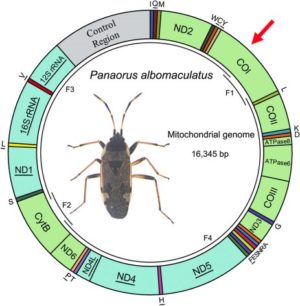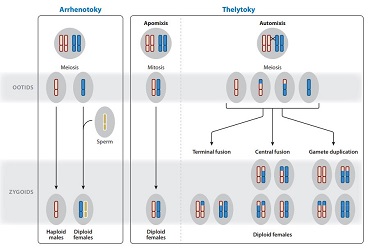Parthenogenesis
Parthenogenesis is a mode of reproduction without fertilization of the female gamete by a male gamete, without contribution of genetic material. This is similar to asexual reproduction.
This mechanism can be observed in plant species but also in invertebrates such as insects and certain vertebrate species such as reptiles.
There are several types of parthenogenesis :
– Parthenogenesis Thélytoque : when the whole progeny consists only of females (ex : aphids, phasmes).
– Parthenogenesis Arrhenotoque : when the whole progeny consists only of males (ex : ants, bees).
– Parthenogenesis Deutheroto-que : when the progeny consists of males and females (example of the butterfly genus Lymantria, aphids) .
Parthenogenesis can be mandatory, exceptional (even accidental), regular or cyclic.
- The example of so-called cyclic parthenogenesis: aphids
In spring (February-March), aphids that emerge from eggs are all females. These females produce asexual female offspring until late summer (thelytoic parthenogenesis). During this period, the offspring are emitted without passing through the egg stage but directly formed (viviparity) (see photo). Thus, populations increase exponentially without recourse to reproduction and males. Then, with the arrival of autumn, these females produce asexual males and females (Parthenogenesis deuterotokus). These asexual male and female individuals will be able to reproduce and mate. Females thus fertilized will lay sexed eggs during the autumn. The eggs will overwinter to generate a new cycle the following spring (see illustration).
caption id=”attachment_486″ align=”aligncenter” width=”669″] Parthenogenetic cycle of aphids (Source: https://www.inra.fr/Grand-public/Sante-des-plantes)[/caption]
Parthenogenetic cycle of aphids (Source: https://www.inra.fr/Grand-public/Sante-des-plantes)[/caption]

- The example of so-called regular parthenogenesis: honey bees (domestic)
A honeybee colony consists of a queen and workers. Only the queen has the power to lay eggs and to generate new workers. All the workers are sisters, they are the result of a fertilization during the queen’s nuptial flight.
Males appear in summer and are derived from eggs produced by the queen but not fertilized (Arrhenotocic Parthenogenesis). The queen has the possibility to choose to fertilize or not each egg she will lay. The males possess only the queen’s genetic material and half that of the workers. During the nuptial flight, the males (also called drones) leave the hive and fertilize other queens to found a new colony. Following reproduction, males die.
A savoir, une larve issue d’un oeuf fécondé, sera soit ouvrière, soit reine. Her fate is determined by the length of feeding with royal jelly, 3 days and she will become a worker, 6 days and she will become queen (see illustration).

Parthenogenesis may have benefits for some species. For example, in aphids, being able to generate a very large population in a very short time without wasting energy and time producing males is an ecological advantage in terms of colonization of the environment and protection against predation.
However, over the long term, it can have negative effects. The multiplication without fertilization decreases the genetic diversity and thus the adaptive power of the species in the face of environmental changes, pathogens, new species…etc.
- In vertebrates
There are several dozen species of reptiles and less than 10 species of fish worldwide that have the power to produce offspring via parthenogenesis. In mammals, this process seems absent and impossible. The mechanisms by which such a process occurs in these species are still poorly understood. There may be other species with this ability that have not yet been observed.





Thanks for the well explained notes on parthogenesis